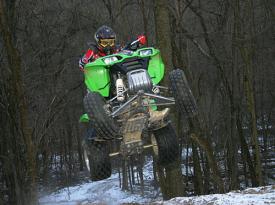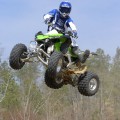2007 KFX700
- Updated: March 11, 2007

By Joe Tolle
photos: Joe Tolle
video: Joe Tolle
test riders: Aaron Meyer, Robby Frede, Joe Tolle

 Four years since its inception, the KFX700 has remained virtually unchanged and for good reason. For the no muss no fuss trail rider out for a fast paced ride, the KFX could be the ideal machine.As with many other ATVs available on the market today, the KFX700 is a “niche” machine. There are machines available in all imaginable displacements, with manual or auto trannies, some have solid axles while others feature independent rear suspension. With so many choices out there and so much marketing directed at the ultra high performing 450 class, its no wonder why so many ATV enthusiasts wind up purchasing the wrong machine to fit their particular needs.
Four years since its inception, the KFX700 has remained virtually unchanged and for good reason. For the no muss no fuss trail rider out for a fast paced ride, the KFX could be the ideal machine.As with many other ATVs available on the market today, the KFX700 is a “niche” machine. There are machines available in all imaginable displacements, with manual or auto trannies, some have solid axles while others feature independent rear suspension. With so many choices out there and so much marketing directed at the ultra high performing 450 class, its no wonder why so many ATV enthusiasts wind up purchasing the wrong machine to fit their particular needs.
This year, Kawasaki is set to take center stage in the 450 class with their all-new aluminum-framed fuel-injected KFX450. Although Kawasaki went to great lengths to make the KFX450 trail friendly, we suspect that it would take quite a rider to take full advantage of all the performance that the KFX450 has to offer out on the trail. If it is at all like its competitors in the class, the KFX450 will most likely prefer to be ridden hard.
With Kawasaki’s 450 getting so much attention from the media right now, we decided to take a look at the 450s bigger brother, the KFX700. Released back in 2004, the KFX700 has proven itself an extremely viable trail machine, winning its share of GNCC championships in the Utility Unlimited class. Obviously there’s no denying its speed capabilities in the woods, however, while it’s not made for a beginner, the KFX has a kinder gentler side that makes it more appealing to those of us who ride below 80% most of the time.

If you have avoided this model due to a belief that CVT transmissions are sluggish and unresponsive, you might want to think again. The KFX700’s CVT is extremely responsive to throttle input. And as for handling, the KFX firm ride helps reduce body roll through the turns.

Even hard core anti CVT junkies like Robby are converted by the KFX 700. Riding in the low traction and horsepower robbing conditions of deep snow was made much easier by the fact that the KFX CTR tranny always had the Kawi in the sweet spot of its powerband.
WHAT IT IS?
Kawasaki’s Prairie 650 sport/utility machine was such a big hit with woods racers and performance minded trail riders, that Kawasaki decided to use the machine’s quick revving torquey V twin motor to create an all new sport specific machine. Kawasaki took the Prairie’s motor punched it out to 697cc and removed the transmission’s lower range to save weight. With the KFX intended as a trail machine, Kawasaki decided to stick with a fully automatic transmission to make the KFX more appealing to a wider variety of riders and skill levels.
The KFX 700 received an all new chassis featuring a single spar lower front frame tube. This design maximizes front A-arm length and minimizes bump steer. Dual A-arms replace the Prairie’s McPherson struts and deliver 9.3 inches of preload adjustable front suspension travel. Out back more user friendly features were borrowed from the Prairie as the KFX700 utilizes the Prairie’s swingarm with its virtually maintenance free shaft drive. A linkless rear shock features preload adjustment and delivers 7.9 inches of travel. The 700’s rear end also utilizes the Prairie’s sealed multi disk rear brake system, which keeps the rear brakes completely protected from the dangers of rocks and mud. Braking up front is provided by dual hydraulic disk brakes with dual piston calipers.

Fueling the KFX takes place at the rear of the machine under this removable body panel. Up front where the fuel tank would normally reside is the machine’s airbox. Kudos to Kawasaki for making the air filter easy to access and maintain.


With the fuel tank over the swingarm to lower the machine’s center of gravity, the KFX has a light front end making it easy to lift the front wheels for trail obstacles, however it requires that you really keep your momentum up on steep hills.
MORE DETAILS
Feeding the KFX700s four valve SOHC liquid four stroke cylinders are a pair of Keihn CVKR-D32 32mm carburetors. Instead of mounting the KFX air-box in the conventional location under the seat, they mounted it higher up where the gas tank would normally reside. This helps keep the air intake farther out of the reach of deep water. Gaining access to the air filter for maintenance is a snap with no tools required.
With a dry weight of 516 lbs, Kawasaki mounted the machine’s 3.2 gallon fuel tank under the seat in order to help lower the machine’s center of gravity. ITP Holeshot tires, (22×7-10 front and 22×11-10 rear) mounted on high quality aluminum rims, help with stability and deliver proven performance in all types of soil surfaces. With a width of 47 inches and a wheelbase of 50.8 inches the KFX numbers are indicative of a stable machine in spite of its heavy dry weight.

The KFX has preload adjustable suspension front and rear. The front shocks deliver 9.3 inches of wheel travel while the rear offers 7.9 inches. The shaft drive and sealed multi disc rear brake system keep maintenance to a minimum.

LET’S RIDE!
 Although we could pitch the KFX sideways in the winter wonderland of southern Ohio, a light front end with plenty of traction in the rear makes the KFX somewhat difficult to slide in high traction conditions. If you’re a slider, things get better as the Holeshot tires wear in a bit.Throw a leg over the KFX and you immediately notice the machine’s spacious ergonomics. For average to large size riders, the layout of the machine is super comfortable making long distance rides less fatiguing. Sure, the midsection is a little fat thanks to the CVT tranny, but it wasn’t enough of a problem to extract as much as a whimper from any of our test riders.
Although we could pitch the KFX sideways in the winter wonderland of southern Ohio, a light front end with plenty of traction in the rear makes the KFX somewhat difficult to slide in high traction conditions. If you’re a slider, things get better as the Holeshot tires wear in a bit.Throw a leg over the KFX and you immediately notice the machine’s spacious ergonomics. For average to large size riders, the layout of the machine is super comfortable making long distance rides less fatiguing. Sure, the midsection is a little fat thanks to the CVT tranny, but it wasn’t enough of a problem to extract as much as a whimper from any of our test riders.
The machine can be started in neutral or in gear with the brakes held in. The same procedure works for switching between forward, neutral and reverse. Depress the rear brake and use the twist selector mounted on the left side of the handlebars. It’s a simple procedure that worked flawlessly nearly 100% of the time.
Hit the gas and the KFX immediately rolls out. The CVT transmission provides the perfect balance between smooth acceleration and fast launches out of the hole. The machine’s big V twin displacement provides a power spread that serves you perfectly whether you are in the mood to putt through the trees or hammer down a long fire road. The KFX delivers power from the crack of the throttle nearly all the way to the stop and seems happy to pull the rider along at any speed in between. Even Pro Am racer Aaron Meyer was impressed with the motor performance of the big KFX. With such strong usable power and a quiet exhaust note, the motor on the KFX is nearly perfect.
 All of our riders felt that the KFX suspension did a decent job of absorbing everything from small roots and rocks to medium sized jumps with no problem. The only place we had an issue with the machine’s shocks was in hard acceleration and braking bumps where the rear shock would pack and make the rear end kick out.While the KFX front brakes provide good stopping power, the rear brakes lack feel and don’t seem to have a real positive engagement, making it hard to lock up the rear end and requiring more pressure than we would like. This becomes very noticeable on long decants where you are forced to solely rely on the KFX brakes to stop its 516 pound dry weight. What’s more in the braking department is the fact that the 700 doesn’t have engine braking instead Kawasaki opted for a “free-wheeling system”. The engine will go into neutral and free wheel. Until you get used to this, it is very scary on downhill descents. The trick is to give it gas all of the time to keep the engine from free wheeling. In other words applying a little bit of throttle actually helped us go slower on aggressive down hills where we did not want to pick up unwanted additional speed by going into neutral.
All of our riders felt that the KFX suspension did a decent job of absorbing everything from small roots and rocks to medium sized jumps with no problem. The only place we had an issue with the machine’s shocks was in hard acceleration and braking bumps where the rear shock would pack and make the rear end kick out.While the KFX front brakes provide good stopping power, the rear brakes lack feel and don’t seem to have a real positive engagement, making it hard to lock up the rear end and requiring more pressure than we would like. This becomes very noticeable on long decants where you are forced to solely rely on the KFX brakes to stop its 516 pound dry weight. What’s more in the braking department is the fact that the 700 doesn’t have engine braking instead Kawasaki opted for a “free-wheeling system”. The engine will go into neutral and free wheel. Until you get used to this, it is very scary on downhill descents. The trick is to give it gas all of the time to keep the engine from free wheeling. In other words applying a little bit of throttle actually helped us go slower on aggressive down hills where we did not want to pick up unwanted additional speed by going into neutral.
Since the KFX suspension rides high in the travel, it relies on firm suspension to help keep body roll at a minimum. At around 150lbs, test rider Aaron Meyer felt that he couldn’t make full use of the machine’s wheel travel. At around 260lbs, test riders Robby Frede and Joe (Magoo) Tolle felt that the KFX suspension was ideal for larger heavier riders. None of our test riders complained about the suspension feeling harsh.
Crawling around in the woods the KFX suspension did a decent job of complying with the demands of roots and small rocks where the machine’s weight plays to its advantage. In more wide open spaces, the 700 eats up bumps, and small to medium size jumps with no problem, however motocross style conditions can overwhelm the KFX shocks. In gnarly acceleration and braking bumps, the rear suspension can pack making the rear end swap thanks to too much rebound damping. Since the rear shock is not rebound adjustable you will just have to back off a bit in these conditions. A good set of aftermarket shocks would lower the machine a bit in the travel making it more stable and cure the rear shocks rebound issues. Don’t get us wrong, the KFX suspension is fine for most riders, but if you like to push it hard all of the time, aftermarket shocks have proven themselves a viable addition to the mighty KFX.
Through the tight woods, the KFX is a surprisingly nimble handler for its size and dimensions. At almost any speed, as long as you aren’t out-riding the machine’s suspension the KFX feels quite stable. Nimble handling in tight conditions bite the KFX a bit when you’re flat out in wide open spaces where its steering feels just a bit too precise giving it a slightly twitchy feeling. The only place we felt the machine was a bit unstable was on side hills where its tall ride height worked against it.
 In spite of a light front end, the KFX is pretty easy to keep under control in flight as our test pilot, Aaron Meyer demonstrates. With the fuel tank residing over the swingarm the front of the machine is quite light, and there is plenty of weight over the rear wheels for traction. This makes lifting the front wheels for logs or other trail obstacles as easy as stabbing the throttle. In fact, you can lift the front wheels just about any time you choose from whatever speed you happen to be riding at. This is one capability not shared on many smaller bore CVT sport machine.
In spite of a light front end, the KFX is pretty easy to keep under control in flight as our test pilot, Aaron Meyer demonstrates. With the fuel tank residing over the swingarm the front of the machine is quite light, and there is plenty of weight over the rear wheels for traction. This makes lifting the front wheels for logs or other trail obstacles as easy as stabbing the throttle. In fact, you can lift the front wheels just about any time you choose from whatever speed you happen to be riding at. This is one capability not shared on many smaller bore CVT sport machine.
The only drawback to the light front end comes on really steep climbs where a lot of forward body position is necessary. Choose a line you can carry your momentum up. You don’t want to have to brake hard and accelerate on this machine with its light front end. Fortunately, there is enough power that you can motor right over most anything you encounter on the way up.
Although we have plenty of sliding pictures from our winter escapades on the KFX, in more perfect traction conditions the front end will generally lift before you break the rear wheels loose, making it difficult to powerslide. The KFX prefers to be driven through the turns pointing the front end where you want to go, with the back tires hooked up. Since the KFX uses a shaft drive, you can’t swap out for a longer swingarm to change the machine’s handling characteristics. You’re stuck with stock, but stock is pretty darn good.
THE BOTTOM LINE
When we started this test, test rider Robby Frede used to laugh when we ordered CVT machines. After riding for this test he was cussing Kawasaki for taking it back so soon. When the test was done we came away with a better understanding of why Kawasaki built this machine. All of its user friendly features such as CVT transmission, easy air filter access, shaft drive and the sealed disk rear brake system added together to create a machine that provides maximum ride time with minimum in-between ride maintenance. ATVing is about getting out and enjoying the great outdoors and the KFX700 provides the least distraction for intermediate to advanced riders who like to watch life go by in a blur of speed.
|
|||||||||||||||||||||||||||||||||||||||||||||||||||||||||||||||||||||||||||||||||||



